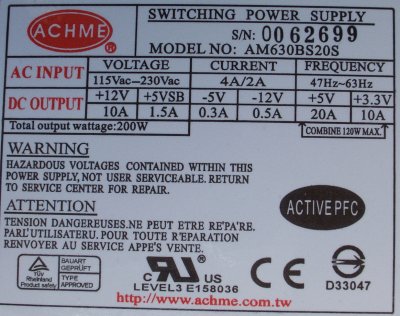Internal I

By removing three thumbscrews, the top cover comes off easily enough. We're then greeted by the above picture. Already you can see just how busy the interior is. The cage that holds the optical, floppy, and hard drives comes away the removal of just two screws. You can also see the approach taking to cooling. I'll talk a little more of this later.

Looking at the cage from another point of view, you can see that we have space for a single 5.25" drive and either 2 hard drives or a hard drive and a floppy drive. I'd be a little concerned with the heat angle if I was specifying 2 hard drives.
Stripping away the cooler, cage, and all associated cables, we are presented with this outlook:

The Shuttle FB51 v1.3 is the motherboard that handles the duties this time around. You can guesstimate its size from the size of the P4 retention bracket in the centre of the above picture. You can also clearly see the AGP (2x, 4x) socket and the single PCI slot that sits above it. Being Intel-powered throughout this time, the new Intel i845GE and ICH4 combination provide the bridge duties. The former is covered by a passive heatsink. The i845GE is something new for Intel. The chipset, with integrated Intel Xtreme i830 graphics, also officially supports PC2700 memory (166MHz); a first for Intel DDR motherboards.
Another notable feature, one that should have Intel fanboys happy, is the support for upcoming HyperThreading-enabled Pentium 4 CPUs. We're still not sure what effect this will have on current applications, but support for it gives the SB51G some form of futureprooing. Due to a lack of 'board real estate, we only have 2 DIMM slots. The upside is that these can each hold 1GB modules, giving a total of 2GB of system memory. The primary and secondary IDE ports sit to the right of the memory slots.

Looking at the motherboard from the opposite side, we can clearly see the floppy drive port and the main 21-pin and 4-pin 12v P4 connector. It's all a little cramped but that's to be expected. We're also given an extra 2 fan headers. I can't exactly see how we're going to make the most of them given our confined space, but it's a thoughtful inclusion.

The PSU is a 1U-sized offering. With a total wattage of 200w, you'd be forgiven in thinking that it will struggle to power any top-end system. You'll soon learn that there's more to this little PSU than meets the eye. It's not necessarily the wattage of a PSU that ultimately counts, its construction and quality of components matter, too. In terms of connectivity, we have 4 standard molex connections as well as 2 floppy style connections.









